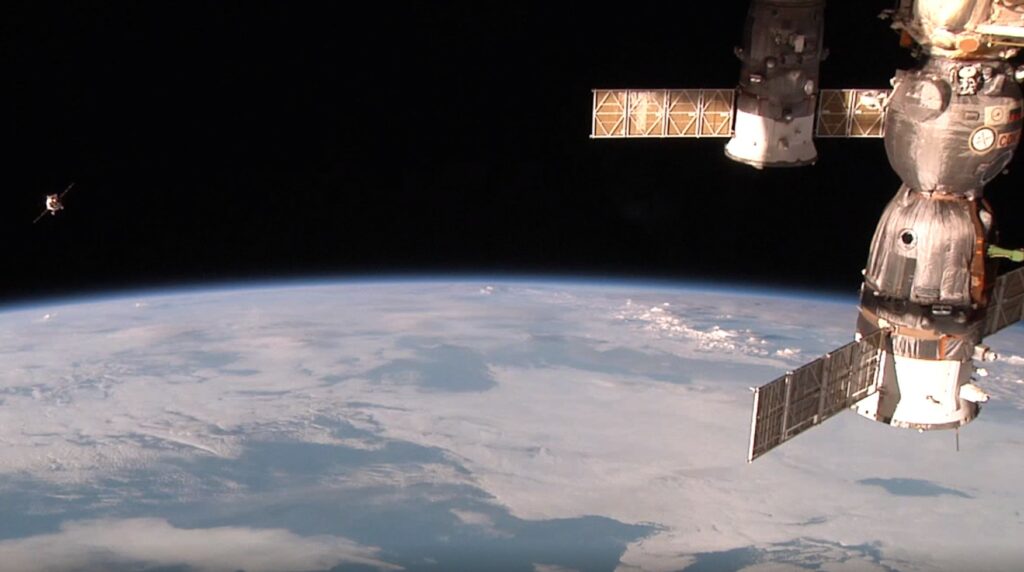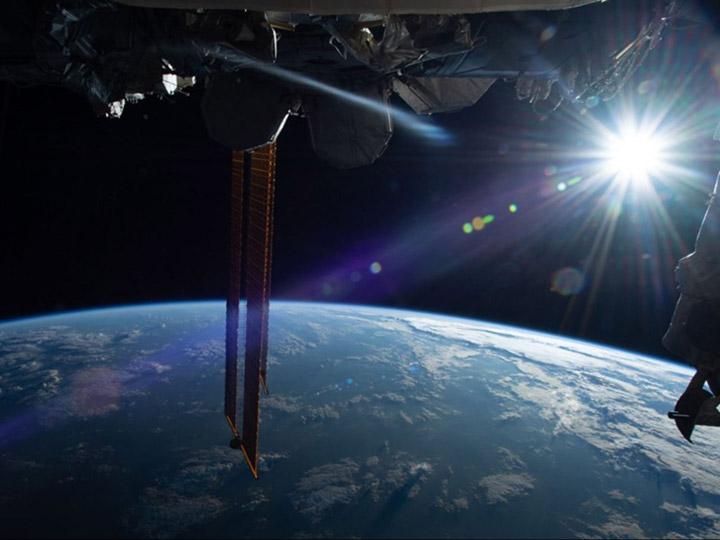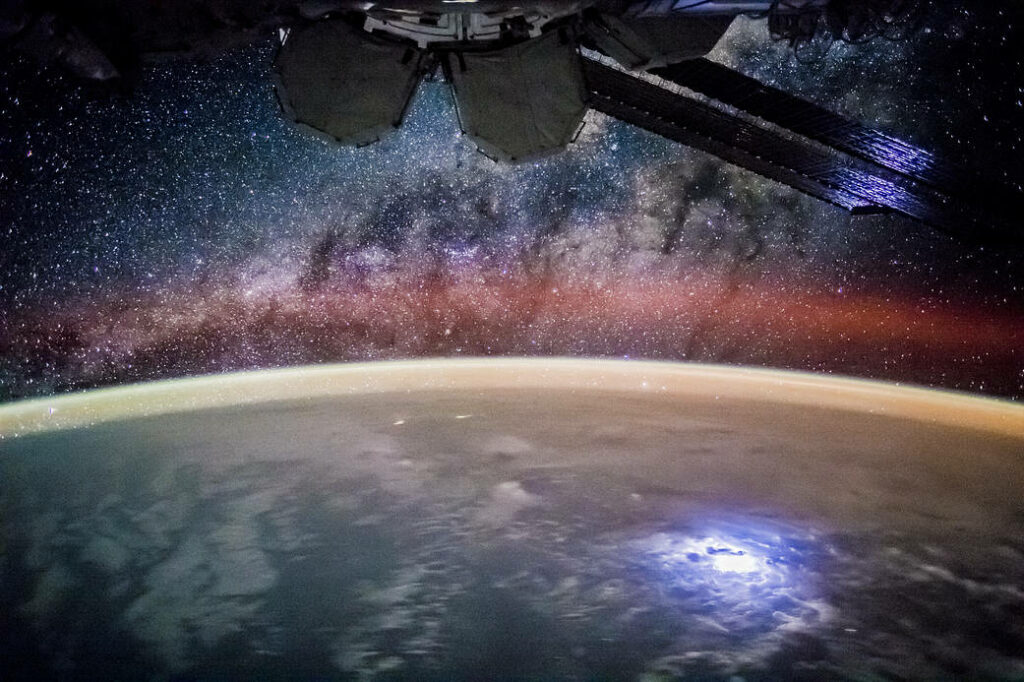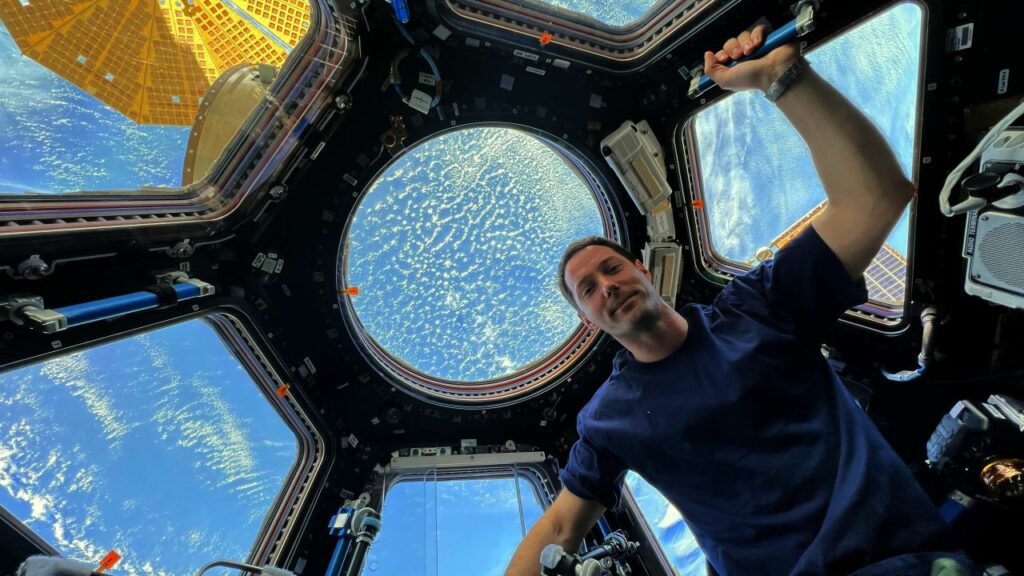In photographs taken from the surface of the Moon or from Earth orbit, the sky appears completely black, and only now and then a star is visible. Meanwhile, astronauts see them regularly and extremely clearly, but only under certain conditions.

Find a star in a photo from orbit
Most people on Earth judge what space is like by the pictures taken by astronauts in flight. Those pictures clearly show that the sky is always dark there. But there is a certain “bug” there. It almost always looks starless.
Consequently, many conclude that they are not visible in space at all, and ask the question: why? In fact, stars are seen by astronauts every day, but they are very rarely represented on pictures. To understand why this is so, one must start with the fact that blackness of the sky does not always mean the possibility of seeing stars.

Why can’t we see the stars by day?
The explanation should begin with the question of why we do not see the stars during the day here on Earth. No, not because the sky is too light at this time. It is blue because our atmosphere partially scatters sunlight, and mainly shorter wavelengths are affected by this process — that is, the blue and violet parts of the visible spectrum.
But the color of the sky does not preclude us from seeing the Moon during the day! Moreover, under certain circumstances, even Venus, Mars and Jupiter can be seen with the naked eye in the daytime sky (if you know where to look for them). The matter is that our eyes adjust to a certain level of illumination. And during the day, sunlight is simply too intense compared to such weak sources of radiation as distant stars. Meanwhile, our natural satellite reflects enough light.
In space, the atmosphere does not interfere. That is why the sky remains dark during the day. But the level of illumination in the presence of the Sun or the sunlit part of the Earth is still too high. And our sight continues to “adjust” its sensitivity to these conditions, so that the stars are not visible in the black sky then.

This can be compared to the situation when, after sunset, you leave the supermarket and enter a brightly lit parking lot. The sky overhead seems to be dark, but at the same time it is extremely difficult to see the stars in it. Almost the same situation exists over the sunlit hemisphere of the Earth because our luminary is much brighter than any lamp.
Did the Apollo astronauts see the stars?
Apollo 11 astronauts, who were the first to reach the Moon, encountered the effect of the dark sky, where stars are not visible. The journalists did not see a single star in the pictures they took, so they asked the heroes after their return if they had seen any during their mission.
To this, Neil Armstrong replied that he had not seen them, and explained why. All manned modules arrived on the Moon during the local daytime, which on our satellite lasts for 14 days and 18 hours on average. The experts concluded that night on the Moon was too dangerous for a human to stay.

In addition, all landings were carried out in the hemisphere of our satellite visible from Earth. Therefore, not only the Sun was in the sky all the time, but also our planet, which can emit almost a hundred times more light than the full moon.
However, after that, Armstrong added that if you hide in the shadow of the lunar module, you can see the brightest stars in the sky. They would be even better visible from the bottom of some very deep crater or gorge, but astronauts did not conduct such experiments.
Why are pictures of stars from orbit rare?
The camera works in the same way as the human eye. Only its sensitivity is regulated by the time during which the light that has passed through the lens illuminates the perceiving element — the film or CCD matrix. It is called shutter speed (exposure), and for shooting stars at night it should be much longer than for shooting objects and landscapes during the day. Therefore, a camera on board a space station flying over the illuminated side of the Earth has even less chance of seeing the stars than the human eye.

It would be reasonable to assume that when a spacecraft or station is over the unlit side of the Earth, there should be no problems with observing distant lights. Indeed, they are visible, and there are plenty of pictures to prove it.
The only problem is that most photos of space show the surface of the Earth, an orbital station, or other space objects. And in the absence of sunlight, they cannot be seen at all or are seen very poorly. Therefore, they are usually shot over the day side. No stars can be traced in such pictures.

In addition to all of the above, the space station has its own lights that illuminate it as it flies over the night side of the Earth. They create light pollution, similar to city lights, which prevent us from admiring the stars directly from the streets. Therefore, it is best to look at the stars in space in the complete absence of light. That is why the two most powerful telescopes — Gaia and JWST — are “hiding” from the Sun behind the Moon staying at the Lagrange point L₂. Their shots of distant space objects are perfect.
